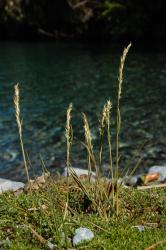- Taxon
- Gallery
Erect ± open tufts to 100 cm, with flat dull green leaves usually « culms and long, narrow-lanceolate, silvery panicles; branching extravaginal. Leaf-sheath to 5 cm, often pubescent or puberulous, sometimes minutely prickle-toothed or glabrous, upper sheaths usually with long fine soft scattered retrorse hairs. Ligule 1–1.5 mm, erose or lacerate, shortly stiff-ciliate, abaxially often with minute hairs. Leaf-blade 3–15 cm × 1–7 mm, sometimes with scattered long hairs, abaxially glabrous to minutely scabrid above, adaxially finely ribbed, ribs minutely prickle-toothed; margins scabrid, sometimes with scattered long hairs. Culm 9–60 cm, internodes mainly glabrous but usually with soft hairs above and below nodes, scabrid to puberulous below panicle and often with a few long hairs, occasionally pubescent to villous throughout. Panicle 3–15–(24) × 0.5–2 cm, lanceolate-oblong, ± spike-like and rachis visible, or lower branches sometimes slightly distant, narrowly branched, each branch bearing few spikelets crowded to base; rachis usually scabrid, sometimes smooth or pubescent, lower nodes often with tufts of long hairs, branches scabrid or sometimes pubescent. Spikelets 5.5–8 mm, light green, purplish or brownish tinged. Glumes subequal, membranous, keels with prickle-teeth in upper ½; lower ≤ upper, elliptic-oblong to elliptic, upper ≈ spikelet, wider elliptic; margins very minutely prickle-toothed near acute or sometimes finely mucronate tip. Lemma 5–6.5 mm, bidentate to shortly bicuspid, closely finely scabrid with prickle-teeth more prominent near keel; awn 4–7 mm, slightly to strongly recurved, insertion in upper ¼ of lemma. Palea minutely prickle-toothed on keels throughout, on flanks, and on margins above. Callus hairs to 0.5 mm. Rachilla hairs to 1 mm. Lodicules c. 1 mm, glabrous. Anthers 0.8–1.3 mm. Gynoecium: ovary to 1 mm; stigma-styles to 2 mm. Caryopsis c. 2.7 × 0.8 mm.
[From: Edgar and Connor (2000) Flora of New Zealand. Volume 5 (second printing).]




